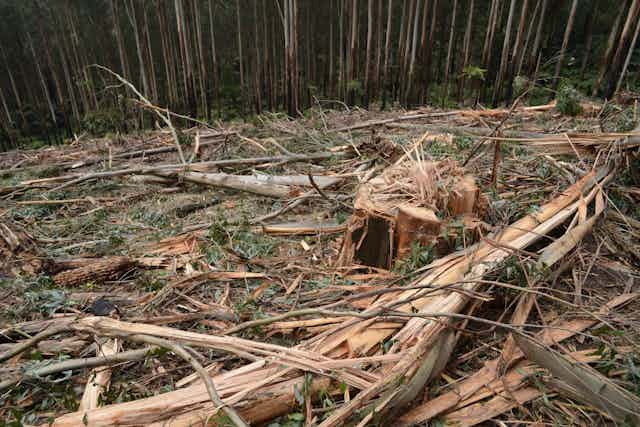The debate over native forest logging has been sparked once again, partly by the government’s successful push for wood burning to be included in the revamped Renewable Energy Target.
However, the disagreement over the best way to manage Australia’s 9.4 million hectares of public native forest is thrown into sharp relief by analysis showing that ending native forest logging, and completing the the industry’s shift into plantations instead, would get Australia much of the way to its greenhouse gas emissions reductions target.
Analysis done using the Australian government’s public native forest model suggests that stopping all harvesting in the public native forest estate would generate in the order of 38 million tonnes of potential credits (that is, the equivalent of 38 million tonnes of carbon dioxide emissions avoided) each year in the short to medium term.
While this is the technical capacity, the Kyoto Protocol’s rules cap credits from forest management at 3.5% of base-year emissions, or around 15 million tonnes of CO2 equivalent per year. So if Australia ratifies the second commitment period of the Protocol, which runs from 2013 to 2020, the cap would limit forest management credits to 120 million tonnes of CO2 equivalent over the commitment period.
The Australian government’s latest emissions projections estimate that, in order to meet its 5% emissions-reduction target in 2020, Australia has to reduce its emissions by 236 million tonnes of CO2 equivalent over the second commitment period. This means stopping harvesting in public native forests could provide 51% of the abatement task to 2020.
Native forest logging results in significant greenhouse gas emissions because typically less than 5% of the biomass carbon of logged forests ends up as long-term timber products like furniture. The majority of the biomass carbon is made into short-lived products such as paper, which simply delays emissions for around three years.
Meanwhile, up to 60% of the remaining biomass in Victorian Mountain Ash forests is logging slash – tree heads, lateral branches, understorey trees, bark and other unwanted forest residues. Most of the carbon stored in this slash is emitted to the atmosphere, either in high-intensity stand-regeneration fires or through accelerated decomposition.
Research shows that the logging of several thousand hectares of Victoria’s Mountain Ash forest each year produces emissions equivalent to about one-third of the annual greenhouse emissions of Yallourn Power Station.
Carbon book-keeping
Since the start of 2013, Australia has been required to account for carbon emissions from forest management in the national greenhouse gas accounts. This includes emissions (and carbon sequestration) due to the management of public native forests (usually known as “state forests”), plantations established before 1990, and private forests that have been harvested since 1990.
The accounting is based on a “baseline-and-credit” system. The Australian government was required to make a projection of net emissions (emissions minus sequestration) from its forest management lands over the period 2013 to 2020. If Australia’s actual net emissions from forest management are below this reference level, it receives credits that it can use to offset emissions from other sectors. If its net emissions are above the reference level, it receives debits.
Phasing out native forestry
The Kyoto cap on forestry credits means that any plan to stop harvesting would be best done in a staged manner, with logging areas progressively being shut down. This would also minimise the transitional issues for workers, while still maximising the claimable carbon credits for Australia. If done well, stopping harvesting in native forests could move workers into more profitable and sustainable plantation-based industries, while providing an ongoing and low-cost source of carbon abatement that can be used to meet current and future emissions targets.
The Australian government could do this using its Emissions Reduction Fund. It could effectively pay states like Victoria, New South Wales and Tasmania for the substantial carbon abatement derived from not logging their native forests. The states in turn could use the money to transition workers out of the native forest sector.
An added benefit of this strategy is that it would remove the major competitive disadvantage faced by the plantation sector, which has to compete against a heavily subsidised and major loss-making native forest logging sector. The impact on wood production would be limited given that plantations are already the source of more than 80% by volume of all wood products.

Don’t burn it
The current policy is almost exactly opposite of what is needed, with wood from native forests (including sawlogs from Victorian forests) set to be burned to generate electricity as part of the Renewable Energy Target (RET). Indeed, the federal forestry minister Richard Colbeck recently admitted that the native forest sector is not viable without burning forests for energy.
However, when it receives renewable energy credits, burning native forest biomass cannot reduce emissions from electricity generation by coal-fired power stations. The way the RET works means that when biomass is burned it merely displaces forms of renewable electricity generation (like solar and wind), rather than coal as the forest industry consistently maintains.
This means that including native forest biomass in the RET will not reduce emissions from electricity generated by coal-fired power stations. But it could very well significantly increase emissions from forest management, thereby making it harder for Australia to reach its emissions target.
Of course, there would be significant other benefits of not logging native forests, including securing the water supply of cities like Melbourne, and better conserving critically endangered species like Leadbeater’s Possum.

